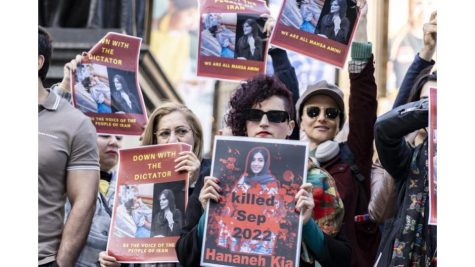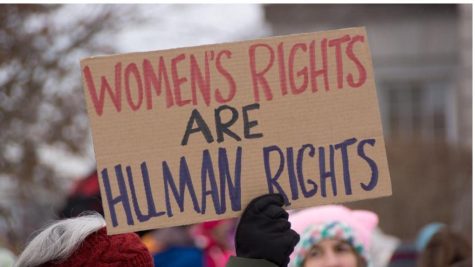It All Comes Down To Choice: A Battle for Feminine Autonomy
October 30, 2022
Photo courtesy of Google
On June 24th, the Supreme Court, through a 6-3 vote, overturned the 1973 Roe v Wade decision, stripping American women of their fundamental right to bodily autonomy.
The Roe case originated in Texas after a woman, Norma McCorvey, requested the termination of her pregnancy. According to an article by History, “at the time of McCorvey’s pregnancy in 1969 abortion was legal in Texas—but only for the purpose of saving a woman’s life.”
Unfortunately, McCorvey did not qualify for an abortion in her home state and did not have the means to travel to acquire one. Therefore, she had to take illegal measures. Unsuccessful in her attempts, McCorvey decided to obtain two attorneys instead.
As stated by History, the case was filed against Henry Wade who was “the district attorney of Dallas County, where McCorvey lived”. Ultimately, it was ruled that in the first trimester of pregnancy, women have the natural right to make their own decisions regarding their bodies. However, as the woman entered her second trimester, the government could begin to regulate abortion if it endangered the mother’s health. Finally, the government could prohibit abortion entirely in the third trimester, if the fetus, and mother, were both completely healthy.
Last June, the United States Supreme Court made the horrifying choice to overturn the 1973 decision. As a result of “trigger bans,” thirteen states banned abortion soon after the ruling. According to The Washington Post, “at least eight states banned the procedure the day the ruling was released.”
Furthermore, The Washington Post says that now, in only “20 states and the District of Columbia abortion is legal, widely available and likely to be protected”. Only 42% of the nation has access to abortion. That’s less than half of the country’s population. It’s sickening.
Elizabeth Mosley, a Ph.D. graduate from the University of Michigan School of Public Health and an assistant professor at the University of Pittsburgh School of Medicine, commented on the negative effects of the ruling in an interview with Michigan Public Health: “We know that getting turned away for abortions means that those patients and their children are more likely to be living in poverty longer—so outlawing abortion will increase the percentage of people and children in poverty.” She also noted the inevitable growth in unsafe self-managed abortions.
Moreover, Mosley explained the effects the overturn has on victims of domestic violence: “We know that turning people away from abortions means they’re more likely to be stuck in domestic violence situations, and so overturning Roe and outlawing abortion will increase the incidence of domestic violence, the severity of domestic violence and increase the percentage of children who are experiencing child abuse.”
Many Americans agree with Mosley. This became painfully evident following the Supreme Court’s decision to overturn Roe. Major cities nationwide began to bustle with pro-choice protests, most commonly led by women aching from their recent loss of civil rights. USA Today noted that there were hundreds of devastated protestors at the steps of the Supreme Court.
Roe. Major cities nationwide began to bustle with pro-choice protests, most commonly led by women aching from their recent loss of civil rights. USA Today noted that there were hundreds of devastated protestors at the steps of the Supreme Court.
A similar race for autonomy is currently taking place in Iran. The laws of this Middle-Eastern country are incredibly misogynistic. According to an article by ABC NEWS, “women must cover their hair with a headscarf and their arms and legs with loose clothing.” Women who do not abide by such sexist laws face punishment as cruel as death.
On September 16th, Mahsa Amini was brutally murdered by the city of Tehran’s morality police. The role of the morality police in Iranian society, as described by NPR, is to “enforce the country’s rules on hijabs and other conservative Islamic modes of dress and behavior.” Under the abhorrent notion that they were protecting the nation’s virtue, the police violently beat and arrested Amini, resulting in her death, claiming that her hijab was being worn loosely.
 Globally, women are now protesting the asinine policies of the Iranian government, disguised as religion. A student at Marshall University in West Virginia, cut her hair in solidarity; “‘To me, it just felt like the right thing to do,’” she told The Los Angeles Times.
Globally, women are now protesting the asinine policies of the Iranian government, disguised as religion. A student at Marshall University in West Virginia, cut her hair in solidarity; “‘To me, it just felt like the right thing to do,’” she told The Los Angeles Times.
Furthermore, in Iran, women have begun to lead their own protests. They are burning their hijabs and chanting for the dismantlement of the dictatorship, and for the freedom of women everywhere.
It is critical to note, though, that neither the act of abortion itself nor the hijab is truly the center of feminine anger. The anger stems from the stripping of self-governance, of choice. Not all people who are pro-choice would obtain an abortion themselves. Not all supporters of Mahsa Amini would take off their hijabs if given a chance. Nevertheless, all of these people share one chief similarity: they would want a woman to have the right to choose–the right to choose to have an abortion or not, the right to choose to wear a hijab or not.
It all comes down to choice.

